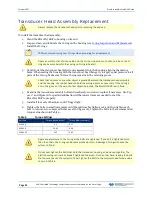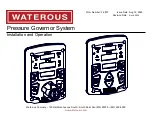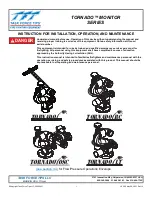
RiverPro and RioPro ADCP Guide
October 2017
EAR-Controlled Technology Subject to Restrictions Contained on the Cover Page.
Page 53
End-cap Replacement
Always replace the transducer head first prior to installing the end-cap.
To replace the end-cap:
1. Stand the RiverPro/RioPro on its transducer face on a soft pad.
2. Inspect, clean, and lubricate the O-ring on the housing (see
O-ring Inspection and Replacement
).
Install the O-rings.
TRDI recommends using new O-rings when preparing for a deployment.
Apply a very thin coat of silicone lube on the O-ring. Using too much silicone lube on the O-
ring can be more harmful than using no O-ring lube at all.
3. Connect the internal power and I/O connector and external power cable connector to their jacks.
4. Place the end-cap on the housing, aligning the mating holes and the beam 3 number embossed on
the end-cap with the beam 3 number embossed on the transducer head. When mating the end-cap
with the housing flange, try to apply equal pressure to all parts of the O-rings. Make sure the face
O-ring remains in its retaining groove.
Check that no wires or any other object is pinched between the end-cap and the housing. Use
rubber bands to hold the wiring in place as necessary. If the O-ring is not in the groove or if a
wire or other object is pinched, the RiverPro/RioPro will flood.
5. Examine the end-cap assembly bolts and washers for corrosion; replace if necessary. Use Figure
17 and Figure 18 for parts identification. All hardware items are needed to seal the RiverPro/Ri-
oPro properly.
6. Install all four sets of hardware until “finger-tight.”
7. Tighten the bolts in small increments until the split washer flattens out, and then tighten each
bolt ¼ turn more to compress the face seal O-ring evenly. Tighten the bolts to the recommended
torque value shown in Table 4.
Apply equal pressure to the O-ring as the bolts are tightened. If one bolt is tightened more
than the others, the O-ring can become pinched or torn. A damaged O-ring will cause the
system to flood.
Do not over tighten the bolts that hold the transducer, housing, and end cap together. The
plastic housing can crack or break if tightened too much. On the other hand, leaving the bolts
too loose can cause the system to flood. Tighten the bolts to the recommended torque value
shown in Table 4.
















































